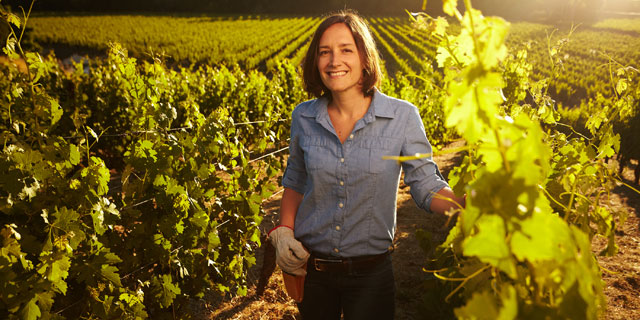Although her earliest memories of wine are drinking Albariño in her native Spain—and smelling the sea in every glass—winemaker Laura Diaz Muñoz is now firmly rooted in Napa Valley. After receiving a Master of Science in Viticulture and Enology from the Polytechnic University of Madrid, Diaz Muñoz worked in La Mancha, Spain and then in New Zealand and Chile before settling in Napa. She has worked very closely with her mentor, Chris Carpenter, the lauded winemaker for Cardinale, Lakoya, La Jota, and Mt. Brave.
Galerie is Diaz Muñoz’s first solo project and she’s working with Napa Valley Cabernet Sauvignon and Sauvignon Blanc from Knights Valley in Sonoma County. In addition to making wine, she recently compiled a small cookbook featuring her family recipes paired with Galerie Wines. We recently had a chance to ask Diaz Muñoz a few questions about wine and food and how to pair them both.
TLK: What area of Spain did you grow up in, and what are your earliest memories of wine there?
I grew up in Alcobendas, a suburb town north of Madrid, and I used to spend my summers in a little village in the countryside in Avila, near Salamanca. My grandparents had a farm with cows, pigs and chickens. I’m a city girl with the heart of a farmer. Although those regions are not wine regions per se, Spanish culture embraces food and wine as part of the normal way of living. My memories go back to when I was just a little girl, where there was always wines at the table (every day for lunch or dinner), or the everyday aperitif when it was normal to go to the bar after the Sunday mass to have some tapas and a glass of wine before heading back home with all the family.
I was a shy girl when I was a kid, so instead of going out with my cousins and brothers to chase swallows, jump walls and swim in the pond, I used to spend the summer days with my grandma at the kitchen, curing meats or cooking lunch by the fireplace.
My first memory enjoying wine goes back to when I was a young girl in Spain and my father and I shared a glass of Albariño when we were vacationing in Puerto de Vega, in Asturias. Puerto de Vega is a little fishermen town and we were having seafood sitting outside a bar in the port. I will never forget how delicious it tasted and how perfect it was with the food, the place, and the wine. In my opinion wine is meant to enhance your senses. That’s the goal of a good wine.
Next, talking California and Spanish wines and a special recipe… [pagebreak]TLK: How do you compare the wines you are making in California to Spanish wine?
I prefer not to compare wine regions. Same when I’m asked about what my favorite wines are. Wine is such a special product because it speaks about the place it comes from and the people who make it. I feel I need to understand the region, the people, and their story together to really appreciate a wine. My Sauvignon Blancs are very Sancerre style but they speak to Napa and Knights Valley. That’s why they are different although they are made under the same winemaking style. Here I’m trying to make wines that stay true to the terroir, under the style I prefer. The same happens with the wines from Spain. Every region has selected the varietals that have better adapted to the place over the years and the long diversity of varietals in Spain and California assures a good pairing with any kind of food.
TLK: What dishes from Spain do you find easiest to recreate in California?
I honestly think that almost every dish could be easy to recreate because California is a privileged place to grow fresh vegetables and to get good meat and fresh fish. One of the key ingredients in Spanish food is the olive oil and California produces one of the best olive oils in the world. Plus nowadays you can get any kind of ingredient here. The only products I miss the most are traditional jamon de Jabugo and salt cod. I try to find good Portuguese markets to get the real salt cod from Portugal.
Now you can recreate dishes from Diaz Muñoz childhood and drink as you enjoy them.
- 4 tablespoons olive oil
- 1 medium yellow onion, diced
- 2 garlic cloves, finely chopped
- 3 green bell peppers, seeded and chopped
- 1/8 teaspoon dried chili flakes
- 4 tuna or bonito steaks, 6 ounces each, 1-1 1/2 inch thick
- 14 oounce can diced tomatoes with juice, or 2 cups of homemade tomato sauce
- 2 taspoons smoked paprika
- 3 russet potatoes, peeled and cut into 1/2 inch dice
- 1 1/2 cups dry white wine



![Making Mealtime Matter with La Familia: Easy Sofrito [Video]](https://thelatinkitchen.com/wp-content/uploads/2015/10/sofrito-shutterstock__0-500x383.jpg)
![Easy Latin Smoothies: Goji Berry Smoothie [Video]](https://thelatinkitchen.com/wp-content/uploads/2015/12/goji_berry-shutterstock_-500x383.jpg)
















![Fun and Fast Recipes: Fiesta Cabbage Salad [Video]](https://thelatinkitchen.com/wp-content/uploads/2015/11/fiesta_cabbage_slaw-shutterstock_-500x383.jpg)









